Our day had begun with coastal shorebirding. As waders are Dave's favourite, we didn't stop searching for them merely because we had turned inland. Instead, we headed for the paddy fields near Kampung Hutan Nibung, where still more species awaited us (including the lovely Black-winged Stilts (Himantopus himantopus) in the photograph at the top of this post).
Hanging about with the stilts was a gang of Ruffs (Philomachus pugnax), an uncommon species in Malaysia. There were about fifteen of them - as Dave reports in his own account, the largest flock he had seen in the country.
Indeed, I didn't quite know where to point my camera first. Stilts are nothing unusual as far as rarity goes, but they are irresistibly beautiful creatures.
Ruffs, by contrast, always look a bit strange to me. None of the birds we saw carried the great feathery capes that give the males of the species their name, but their pigeon-headed, seemingly egg-bound sillhouettes are like no other shorebird.
Wood Sandpipers (Tringa glareola) are far more ordinary (and prettier, to my eye). This must be one of the commonest waders to visit Malaysia; though Penang is much more on the flyway of migraating waders than is Sarawak, where I do most of my birding, this species seems to be equally common in both places.
Smaller shorebirds included a few Little Ringed Plovers (Charadrius dubius), another species I see in both West Malaysia and Sarawak.
The Little Stint (Calidris minuta), though, is only a vagrant in Borneo. This is where it is useful to have Dave as your guide; he has the identification of the smaller shorebirds down to a fine art, and on my own I might have passed this one by.
In fact, if you want to know why this is a Little Stint. and not the commoner Red-necked Stint (Calidris ruficollis) in winter plumage, please hop over to Dave's writeup where he provides you with a detailed side-by-side comparison. I can't do better than that.
There were two other stints foraging on the paddy mud: Long-toed (Calidris subminuta) and Temminck's (Calidris temminckii), the latter (according to ave) a rarity in Penang. That's Temminck's on the left.
For a North American birder, the easiest way to think of the Long-toed Stint is as the Asian equivalent of our own Least Sandpiper (Calidris minutilla), its closest relative. Like the Least, it is a rather slender little bird, with yellowish legs, a barred breast and a predilection for mudflats. It has longer toes, but try to spot those in the mud.
Temminck's Stint is a much more distinctive bird, quite unlike anything in North America: a stint (or peep, if you prefer) almost devoid of streaking of any kind, at least in winter plumage. It looks more like a miniature Common Sandpiper (Actitis hypoleuca). Much of the population winters in Africa, so Southeast Asia is a bit off the beaten path for this one.
It is probably impossible to identify pond-herons in non-breeding plumage, but I am calling this one a Chinese Pond-Heron (Ardeola bacchus) purely because it is the most likely of the three species to show up in a Malaysian rice paddy in winter. Either of the other two (the Indian Pond-Heron (A. grayii) or the Javan Pond-Heron (A. speciosa)) would be something of a find, at least in West Malaysia.
From the paddy fields we drove north to completely different habitat: the Air
Hitam Dalam Educational Forest, a tiny (11 ha) bit of swamp forest that is popular with local nature photographers (check out this site for some spectacular examples of the results).
We had only time for a brief stop, but it did give me a chance to get on clse terms with this delightful little Mangrove Blue Flycatcher (Cyornis rufigastra). According to Dave, the bird was habituated to photographers and undoubtedly expected us to supply a mealworm or two (which we didn't have) in return for a few nice poses.
I doubt that this Blue glassy tiger (Ideopsis vulgaris) expected anything from us, but it posed nicely all the same.
By now it was almost dusk, and we were off to a nearby spot for our final bird specialty. As we drove, a flock of Asian Openbills (Anastomus oscitans) - Dave estimated that there were some 450 of them - flew past on their way to roost.
The specialty was the Great Eared-Nightjar (Lyncornis macrotis), surely one of the weirdest-looking birds I have ever seen. It's the ear-tufts, of course - they make it look like a cross between a bird and a cat, or perhaps one of the odder Egyptian deities. We saw a few birds, and were able to get quite close to one (Dave got some good flight shots) - certainly close enough for me to be extremely happy with the results, and more than satisfied indeed with the whole day. Thanks, Dave!











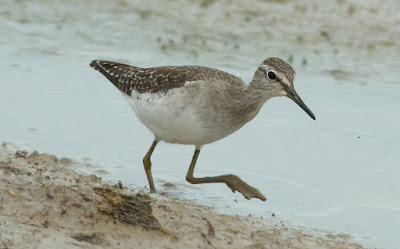

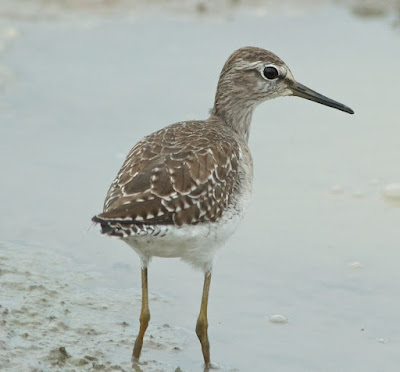







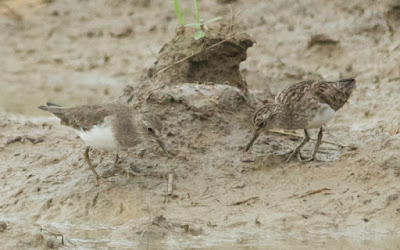



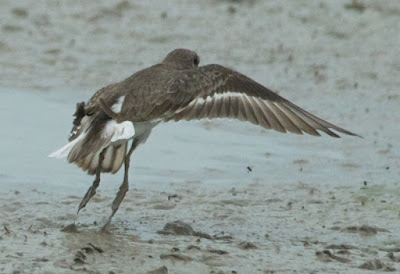
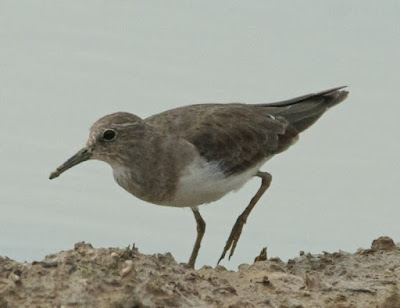







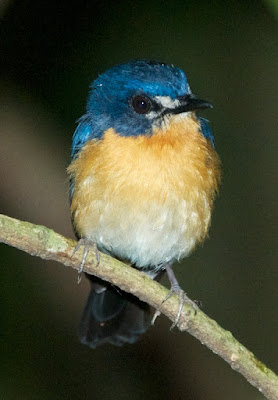

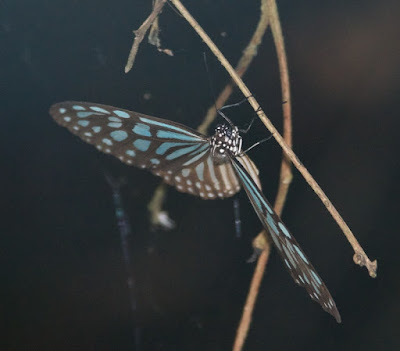




No comments:
Post a Comment